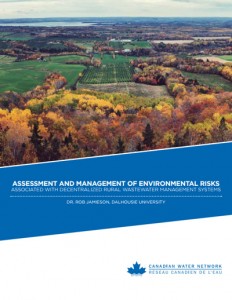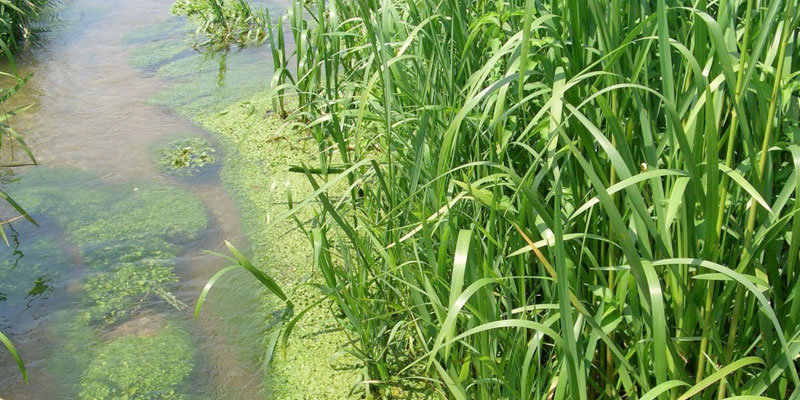Assessment and Management of Environmental Risks Associated with Decentralized Rural Wastewater Management Systems
Principal Investigator - Rob Jamieson, Professor, Dalhousie University, 2008 - 2012

Challenge
Approximately twenty percent of the Canadian public relies on an on-site wastewater treatment system for domestic wastewater management. This percentage is even higher in certain provinces: approximately fifty percent of the population of Nova Scotia uses on-site wastewater management systems. Although most provinces have quite detailed technical guidelines for the design and installation of on-site wastewater treatment and disposal systems, these systems can still pose significant risks to both surface and groundwater resources. Many systems are not maintained, or they are improperly designed and constructed, which can lead to poorly treated water and have major implications for human and environmental health. Currently, most provincial guidelines lack requirements for ongoing inspection and maintenance of onsite systems. Information regarding the long term performance of onsite systems is needed to predict the water quality impacts of onsite systems, and to plan inspection and replacement strategies.
This project, led by Dr. Rob Jamieson, assesses the treatment performance of various types of onsite systems and examines various design alternatives. The research involved quantifying pollutant loadings from onsite systems at the field and watershed scale and developing watershed modeling tools to assess the risks posed by these types of wastewater systems.
Project
This project examined onsite wastewater systems; comparing different design alternatives under varied wastewater loading regimes, and studying the lifespan of the systems. This involved constructing and monitoring field scale onsite wastewater systems. The team tracked long-term changes in water quality under various controlled loading conditions. Data from these systems was also used to calibrate and validate computer models that simulated water and contaminant movement through the systems.
The research has shown that a variety of onsite wastewater treatment systems used throughout Eastern Canada are capable of providing excellent treatment of wastewater, producing effluent with very low average concentrations of parameters of concern such as total suspended solids or E. coli bacteria. The team also found that treatment performance of some designs can be extremely variable depending on loading rate, loading method and external hydrologic inputs. However, one particular design, the lateral flow (sloping) sand filter, provided a very high level of treatment for water quality parameters of interest to regulators.
Knowledge and modeling approaches were used to develop watershed scale assessment tools. A watershed simulation framework was developed, which involved the integration of the Soil and Water Assessment Tool (SWAT) with a new model (POWSIM-Phosphorus On-site Wastewater Simulator). This integrated modeling approach was then successfully applied within the Thomas Brook Watershed in Nova Scotia. The team also developed and tested a GIS (Geographic Information System) -based semi-quantitative risk assessment model for potential onsite system impacts. When the model was applied to Huron-Kinloss Township in Ontario, at-risk areas were successfully identified and validated by local experts.
Outputs
End user oriented reports:
- The effects of dosed versus gravity fed effluent loading on the hydraulic functioning of contour trench disposal fields. Report prepared for Nova Scotia Environment and Wastewater Nova Scotia.
- Development of a Hybrid Constructed Wetland. Final report to Canada Mortgage and Housing Corporation.
- Reed Bed Filter for Septage Treatment. Final report to Ontario Ministry of the Environment.
- Hybrid Constructed Wetland for Small Community Wastewater Treatment and Reuse FactSheet.
- Wastewater Treatment and Reuse Case Study – El Attaouia, Morocco.
Tools:
- Phosphorus On-Site Wastewater Simulator (POWSIM): This tool was developed to link with the Soil and Water Assessment Tool (SWAT) to provide an integrated physically-based modeling framework for quantifying the impacts of on-site wastewater systems at watershed scales.
- On-Site Wastewater Risk Assessment Mapping Tool: This tool was developed as a GIS-based semi-quantitative mapping tool that can be used to assess the relative risk of on-site wastewater impacts at the watershed scale.
- National Training Program for Community Based Drinking Water Monitors on First Nation Reserves (training manual, Source Water Protection DVD, training DVDs and online exam for Health Canada)
- Septic System Video for First Nation Communities (developed for Health Canada)
Workshops and meetings:
- Presentation at Wastewater Nova Scotia 2011 Annual General Meeting and tour of the Nova Scotia On-site Wastewater Research Centre.
- Presentation to highlight research results – Cornwallis Headwaters Society 2011 Annual General Meeting.
- Design seminar on decentralized wastewater management to the largest engineering firm in Morocco and watershed basin association
- Seminar on decentralized wastewater systems to planners from First Nation Communities across Quebec
Outcomes
- Changes in practice – based on the strength of the research results that indicated the success of the sloping sand filter design in treating wastewater, Nova Scotia Environment included the technology in a technical guideline outlining acceptable forms of treatment. Its inclusion in the guideline has provided more options to homeowners when installing new treatment systems.
- Informing investment decisions – the quality of the treatment system, as well as the lower cost of installation in some cases, has led to broad uptake of the technology. In 2010 alone, sloping sand filters were the second most installed systems in Nova Scotia with 340 new installations.
- Changes in practice related to wastewater treatment systems – the Ontario Ministry of the Environment has started granting Certificates of Approval for full scale application of septage reed bed filter technology.
- Capacity-building – this project has led to opportunities in Ontario and Nova Scotia for training at the onsite wastewater research and demonstration facilities developed through the project.





